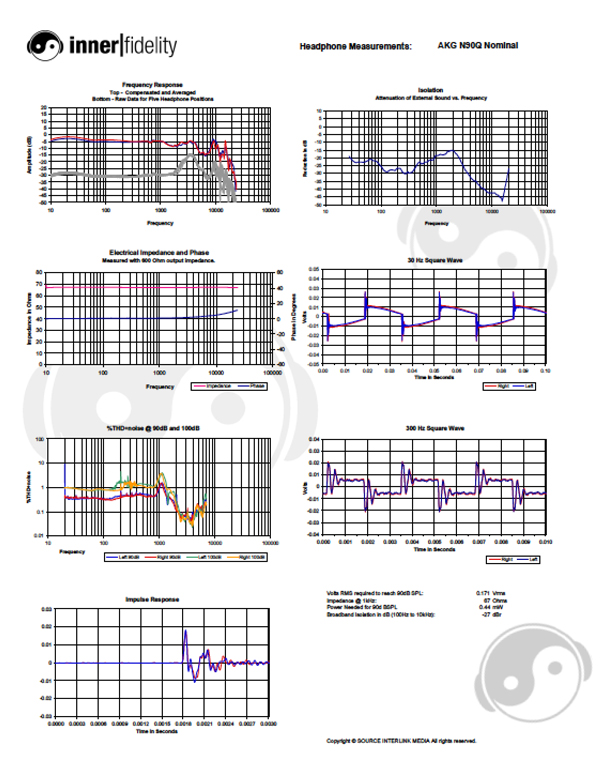| Columns Retired Columns & Blogs |
AKG N90Q Noise Canceling Auto-Calibrating Over-Ear Headphones Measurements
Measurements


Click on graphs image to download .pdf for closer inspection.
Plots on this page were taken in Standard Stage mode and with EQ set to the middle position. Tru note calibration was done once at the beginning of the first four FR sweeps in various positions around the ear, and once prior to the last center position FR sweep ensuring best case calibration for other response measurements thereafter.
Interestingly the response curve from 10Hz to about 2kHz matches the shape of the Harman target response (HTR) curve but has only about 40% of the amplitude of the HTR. When EQ is dialed to max (plot seen on page 2 of this review) it does quite closely match the HTR, but the peak at 3.5kHz is about 2-3dB too high.
Raw response above the 3.5kHz peak shows a significant dip 4-6kHz followed by a significant rise to 10kHz and a well shaped, but 3dB too hot on average response in the top octave. For me, I heard this vocals sounding a little stuffed up in the nose, and airy cymbals that had too much tiss and not enough tang.
30Hz square waves show a remarkably horizontal wave top, even with a slight bow upward indicating a small low frequency emphasis. The bass here is potent and nuanced; very well controlled, which can in part be seen in the perfectly horizontal distortion plot into the low bass. (The relatively high distortion number comes from slightly excessive noise in the headphones. Bass sounded very undistorted and clear to me.)
300Hz square wave is nicely horizontal indicating good low-treble to high-mids transition, but initial spike and following ring are troublingly high. I know the research includes an overal warm tilt in the EQ to compensate for distance and directionality of speakers in a room. But I think they've slightly missed the boat on this compensation...at least to my ears. The TruNote calibration always seemed to me to make more right this area of response, maybe they just need to filter it a little more aggressively. This assertive wiggle does seem audible to me.
Impulse response likewise shows a fairly strong subsequent ring. I will point out that the initial transient is very clear. Also observable is about 1.5mSec of latency through the ADC-DSP-DAC loop. This is not enough to be troublesome evidently, a little Google says +/-20mSec is the agreed upon acceptable perception limit.
It seems to me much of the THD+noise measurement here is dominated by the broadband noise from the electronics in the Q90N. Otherwise distortion has few features until a blip at about 1.1kHz. I did feel like I heard some hardness in this area of response, and it did feel like this exacerbated the dry, artificialness to the treble.
I wonder how much of my impression of an unappealing treble is due to all the digital processing going on. I think manufacturers in the future will find that very high bit rate and depth digital processing will yield a significantly improved subjective experience in the up-close and personal world of headphone listening.
Surprisingly, for an electronic headphone, the input impedance is a nice flat 67 Ohms with very little phase shift in the treble. Most input impedances to electronic headphones is in the many thousands of Ohms range. It seems to me, AKG chose to put a load resistor in parallel with the input. I like this approach because most player electronics will be designed to drive this type of load, typical of an average headphone. If you present a high input impedance load to a headphone output of a typical player, it might promote instability in that amplifier. It also lessens the effect of needing a large input coupling capacitor, or its effects on low frequency phase performance.
Isolation is only slightly bettered by the Bose QC35, and extends well into the very low frequencies. At -27dB broadband, this is excellent isolation for a noise canceling headphone.
With 171mVrms needed to achieve 90dBspl at the ear at max volume setting on the headphones, the N90Q will be able to reach very solid listening levels, but some may find it limited.
- Log in or register to post comments




































